Four vibrant Italian recipes from the sun-soaked island of Sicily
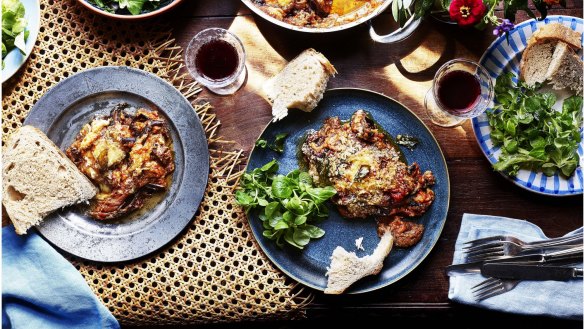
The food of Sicily is many things: frugal yet glamorous, simple yet robust, beautiful yet modest. Its influences are diverse, drawn from across the Mediterranean, Europe and North Africa. And it's one of the oldest, most varied food cultures in the region, says London chef Ben Tish.
"There isn't a country that I know with a richer ... tapestry of cultural influences," Tish writes in his new cookbook Sicilia: A Love Letter to the Food of Italy.
"The Moorish and Norman occupation of the island brought culinary innovations and advanced cooking techniques in tandem with the introduction of exotic fruits and vegetables to an already abundant and fertile soil – citrus, almonds and spices mixing harmoniously with the simple indigenous olives, vines and wheat."
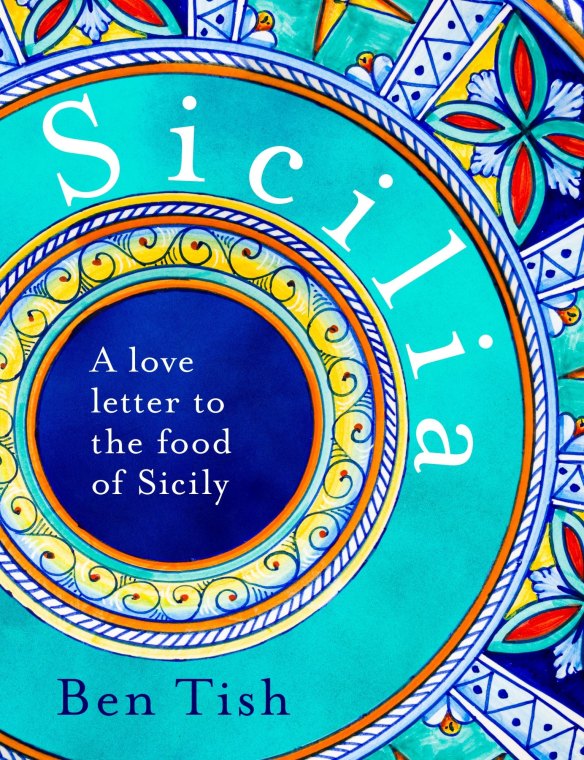
Here is a selection of recipes inspired by Sicily's sun-soaked way of life.
Eggplant parmigiana
Contrary to popular opinion, this delightful and indulgent slab of Mediterranean comfort food hails from the south. Whilst its eponymous namesake, parmesan or parmigiana, originates from the north of Italy, the other key ingredients, eggplants, tomatoes and mozzarella (or burrata in this case, as I find it makes its own creamy sauce) are from the south, and into Sicily. Wherever it comes from, it's a classic and known worldwide. At Norma I elevate it to include a rich parmesan cream that was poured over at the end, for extra indulgence, and crispy basil leaves strewn over at the end.
INGREDIENTS
- 1.2kg or 2 litres quality canned chopped tomatoes
- 150g fresh cherry tomatoes, cut in half
- 8 eggplants ends trimmed
- extra virgin olive oil
- 250g dried breadcrumbs
- a handful of basil, leaves picked
- 4 x 120g burrata, drained
- 250g parmesan, grated
- sea salt and freshly ground black pepper
METHOD
- Put the canned and fresh tomatoes into a saucepan and simmer over a medium heat to slowly reduce by half. Reserve.
- Cut the eggplants lengthways into slices about 2cm thick.
- Heat a large, heavy-based frying pan over a medium heat. Pour in some olive oil and, when hot, gently fry the aubergines slices, in batches, until tender and golden brown on both sides. You will need to add extra oil as you go as the eggplants soak it up quite quickly. When the slices are fried, season well and drain on kitchen paper.
- Preheat the oven to 180 fan-forced (200C conventional).
- Rub the inside of an ovenproof dish (I use a terracotta or a metal dish for a rustic look) with olive oil. Make a layer of eggplant slices on the bottom, then sprinkle with breadcrumbs and a few basil leaves followed by a ladleful of tomato sauce, a burrata ripped into pieces and a handful of parmesan. Ensure everything is evenly spread, then continue layering this way, finishing with a layer of eggplant. Reserve some breadcrumbs, parmesan and basil.
- Bake for 40 minutes or until the parmigiana is bubbling away and the aubergines on top have begun to crisp.
- Remove from the oven to rest for 20 minutes, then sprinkle with the reserved breadcrumbs and parmesan, and finish under a hot grill for 5 minutes. Scatter the remaining basil leaves on top before serving.
Serves 6-7
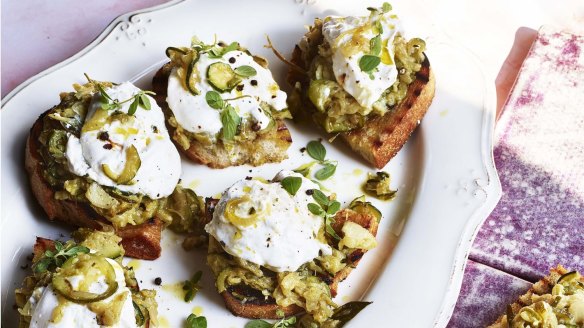
Burrata on bruschetta with stewed zucchini and fennel with marjoram
I love fresh Italian cheeses such as ricotta, mozzarella and stracciatella, but burrata sits top of the list. Burrata is essentially mozzarella, which is made from cow or buffalo milk, on the outside, filled with extra creamy stracciatella on the inside; when you cut it open, it oozes out in the most deliciously enticing way. I sometimes use it for cooking where it works brilliantly in my eggplant parmigiana. But the super fresh cheese – burrata should ideally be eaten within 24 hours of being made – is best eaten very simply with some bruschetta and vegetables. The stewed zucchini and fennel can be made in a larger quantity and then stored in the fridge to be served with grilled meats and fish.
INGREDIENTS
- 4 x 120g pieces of very fresh burrata
- 4 slices of sourdough bread
For the stewed vegetables
- extra virgin olive oil for cooking and drizzling
- 1 garlic clove, finely chopped
- 1 shallot, sliced
- 1 bay leaf
- a sprig of rosemary
- 1 fennel bulb, cored and finely sliced
- 500g zucchini, trimmed and finely sliced
- 1 tablespoon red wine vinegar
- 1 teaspoon demerara sugar
- marjoram leaves
- sea salt and freshly ground black pepper
METHOD
- First make the stewed vegetables. Heat a heavy-based saucepan over a low heat and add a lug of extra virgin olive oil followed by the garlic, shallot, bay leaf and rosemary. Cook gently until very soft but without colour. Now add the sliced fennel and cook for 5 minutes or until tender. Add the courgettes and sprinkle in the vinegar, sugar and some seasoning. Stir, then simmer everything together for 20 minutes or so until tender. Cool before transferring to a bowl and chill for at least 2 hours (or overnight).
- Remove the burrata and stewed vegetables from the fridge.
- Heat a ridged cast-iron grill pan. Rub the sourdough slices with extra virgin olive oil and season. Grill to colour both sides. Place these bruschetta on plates.
- Spoon the courgette and fennel stew on to the bruschetta and top with the burrata. Season the burrata and drizzle over some extra virgin olive oil, then sprinkle with marjoram leaves.
Serves 4
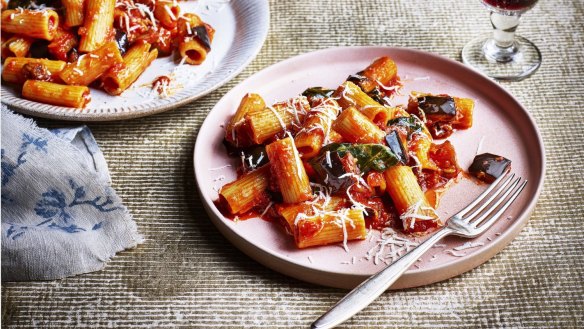
Pasta alla Norma
Pasta alla Norma has become the unofficial signature dish of Sicily. Originally created in the city of Catania around the same time as Vincenzo Bellini's romantic opera Norma, it is said that the pasta was created as a homage to the composer and to the opera. Another story tells of a talented home cook who served her creation to a group of gourmands and was duly christened at the table via the classic Sicilian compliment of Chista e na vera Norma ("this is a real Norma"). Whatever the truth, the dish became an instant classic and its fame spread around the world.
INGREDIENTS
- 2 firm eggplants, trimmed and cut into 2cm dice
- 150ml extra virgin olive oil
- ½ onion, finely chopped
- 2 garlic cloves, finely chopped a good handful of basil leaves
- 800g quality canned chopped tomatoes or passata
- 400g dried rigatoni
- 200g ricotta salata cheese, grated
- sea salt
METHOD
- Put the diced eggplants in a colander in the sink and sprinkle with salt. Leave to drain for 30 minutes.
- Preheat the oven to its highest temperature, around 230 fan-forced (250 conventional).
- Rinse the eggplant in cold water and pat dry with a kitchen towel, then toss in a bowl with half the oil. Spread out on a baking tray, place in the oven and cook for 15-20 minutes or until caramelised, turning occasionally to make sure the pieces don't dry out.
- Meanwhile, heat the remaining oil in a medium saucepan over a medium heat and add the onion and garlic. Saute for a couple of minutes, then add half the basil and the tomatoes. Bring to a simmer. Turn down the heat and cook gently for 23-30 minutes or until thickened (the exact time will depend on your canned tomato brand).
- When the sauce is almost ready, cook the pasta in plenty of boiling salted water according to the packet instructions to al dente. Add the aubergine to the sauce. Drain the pasta (reserving a little of the cooking water) and toss in the sauce. If the sauce seems too thick, add some cooking water to loosen.
- Divide among the plates and sprinkle with the ricotta and remaining basil leaves, roughly torn over the top. It's best to allow this to cool slightly before eating.
Serves 4
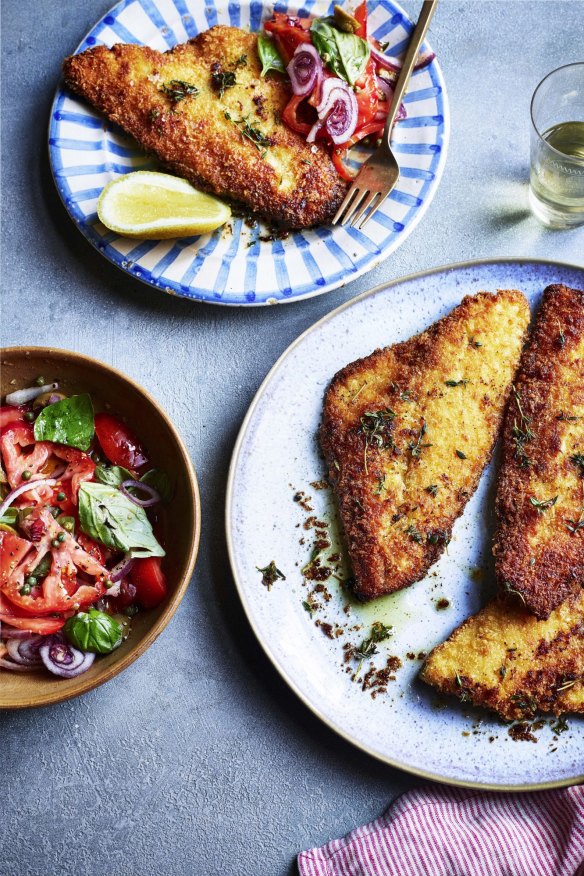
Warehou (sea bream) with almond and breadcrumb crust, vinegar and thyme
Sicilians love a coating of breadcrumbs on their fish (and meat) and in this recipe it not only gives a reassuring crunch but also ensures the fish is kept deliciously moist and juicy. The vinegar, traditionally a preservative to extend the shelf life of less than fresh fish, adds a lovely piquant flavour. Ensure the vinegar is of very good quality and use a sweeter variety such as a chardonnay.
INGREDIENTS
- 4 large warehou (sea bream) fillets, skin lightly scored
- 100ml sweet white wine vinegar (eg, chardonnay or moscatel vinegar)
- 100g panko breadcrumbs
- 40g ground almonds
- plain four for dusting
- 1 free-range egg, beaten
- extra virgin olive oil for cooking
- ½ small handful of thyme
- sea salt and freshly ground black pepper
METHOD
- Place the fish fillets in a bowl, season well and pour over about 75ml of the vinegar. Leave to marinate in the fridge for an hour.
- Drain off the vinegar and dab the fillets dry. Mix the breadcrumbs with the ground almonds. Dredge the fillets in flour, then dip into the egg and coat with the breadcrumb-almond mix.
- Heat a large saute pan over a medium heat. Pour in olive oil for shallow frying – you'll need a good amount, perhaps 1cm in depth. When the oil is hot carefully lay the fish, skin side down, in the pan and fry for 3 minutes or until golden brown and crunchy. Turn the fish over, add the thyme sprigs and continue to fry for a further 2-3 minutes or until cooked through and golden brown.
- Pour the remaining vinegar over the fish, then remove the fillets from the pan to drain on a kitchen towel. Serve hot with the thyme-infused oil and vinegar pan dressing spooned over.
Serves 4
This is an edited extract from Sicilia: A Love Letter to the Food of Italy by Ben Tish, published by Bloomsbury, RRP $52.99. Buy now